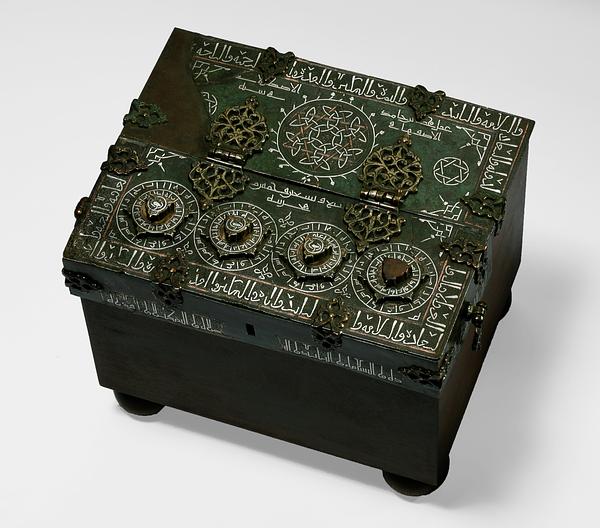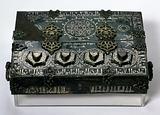Fragment of a box with a combination lock, cast and hammered brass, inlaid with silver and copper
Iran, Isfahan?; 597 H = 1200-1201
H: 4.4; W: 23.5; D: 18.5 cm
This combination lock is the work of the astrolabe-maker Muhammad ibn Hamid al-Asturlabi al-Isfahani in 597 H. At around the same time, the mechanical genius al-Jazari described a similar lock in his Book of Ingenious Mechanical Devices. The combination lock must thus be common property, a scientific invention whose origins can be traced back to the Mediterranean cultures of Antiquity.
The four double dials, each of which can be set in 16 positions, allows for 4,294,967,296 combinations. When the right combination is entered, it releases the inner metal plate, which is attached both to an external handle and to the locking mechanism itself.
Inv. no. 1/1984
Published in:
Oliver Hoare, David Sulzberger: 33 masterpieces of Islamic art from Ahuan Islamic Art 1974-1984, London 1984, p. 23;
Kjeld von Folsach: Davids Samling gennem 24 år, 1962-1985 = The David Collection: a 24-year period: 1962-1985, København 1985, pp. 54-55;
Francis Maddison: “Al-Jazari's combination lock: two contemporary examples” in Oxford studies in Islamic art, 1, 1985, pp. 141-157;
Art from the World of Islam. 8th-18th century, Louisiana, Humlebæk 1987, cat.no. 89;
Kjeld von Folsach: Islamic art. The David Collection, Copenhagen 1990, cat.no. 363;
Kjeld von Folsach, Torben Lundbæk and Peder Mortensen (eds.): Sultan, Shah and Great Mughal: the history and culture of the Islamic world, The National Museum, Copenhagen 1996, cat.no. 82;
Kjeld von Folsach: Art from the World of Islam in The David Collection, Copenhagen 2001, cat.no. 597;
Ahmed Djebbar (ed.): L'age d'or des sciences arabes : exposition présentée à l'Institut du monde arabe, Paris 25 octobre 2005-19 mars 2006, Institut du monde arabe, Paris 2005, cat.no. 151, p. 277;
Jon Millington: Early combination padlocks, Bristol 2010, p. 11;
Sheila R. Canby [et al.]: Court and cosmos: the great age of the Seljuqs, Metropolitan Museum of Art, New York, New Haven 2016, cat.no. 110, p. 118;
Sonja Brentjes (ed.): Routledge handbook on science in the Islamicate world: practices from the 2nd/8th to the 13th/19th centuries, Abingdon 2022, fig. 1.9.2, p. 120;
Glaire D. Anderson: A bridge to the sky: the arts of science in the age of 'Abbas Ibn Firnas, New York 2024, fig. 2.27, p. 69;


